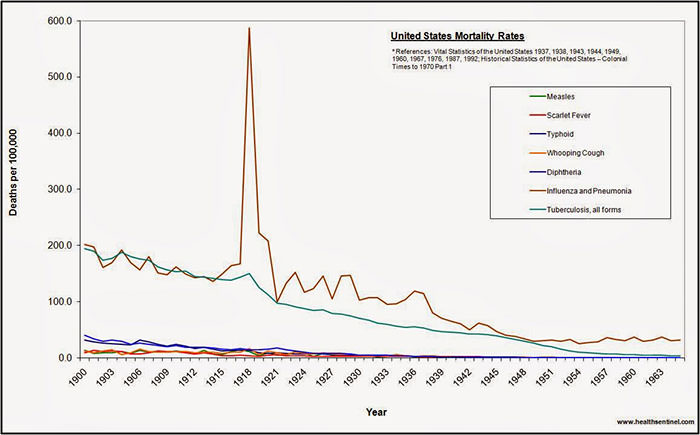Background
Influenza has the potential to become a worldwide epidemic and to affect large portions of the human population, with numerous consequences. Unlike seasonal influenza epidemics, pandemics occur irregularly and can spread quickly due to increased commerce and air travel. Also, unlike the average 36,000 deaths per year due to seasonal epidemics, pandemics can cause hundreds of thousands of deaths within the US alone. Characteristics and challenges of flu pandemics include rapid worldwide spread, health care systems that become overloaded, inadequate levels of medical supplies and manpower and economic and social disruption (Flu.gov, 2011). The figure below shows annual US mortality rates from various causes from 190900-1965. The enormous spike in deaths due to influenza and pneumonia in 1918 is impressive to say the least.

Source: https://www.learnodo-newtonic.com/spanish-flu-facts
Worldwide the great influenza of 1918 is believed to have caused at least 25-50 million deaths. Many believe it is inevitable that period influenza pandemics will continue to occur in the future. It is therefore imperative that we understand the causes and prepare for the next pandemic.
The video below (2:37 min) provides a glimplse of the devastating effects of the 1918 pandemic.
Viruses are non-living. They must reproduce by entering an animal or plant cell (i.e., a host) and using the hosts cell's organelles energy and nutrients to synthesize copies of the viral proteins and viral genetic material (DNA or RNA). Once these components have been replicated they self-assemble to form new virus particles.
Anatomy of the Flu Virus
The influenza virus has a nucleic core with genetic material surrounded by a membrane bound protein coat consisting of four proteins:
- Hemagglutinin protein (H protein): the viral protein that enables it to attach to a host cell.
- Neuraminidase (N protein): an enzyme that cleaves sialic acid residues on hemagglutinin. This is essential for release of the progeny virus after the infected cell lyses.
- The M1 matrix protein
- The M2 ion channel
Within the Orthomyxoviridae family of RNA viruses there are A, B and C types of influenza viruses. The A and B viruses cause seasonal epidemics throughout the world, while the C virus only causes mild illnesses and is not thought to cause epidemics.
- Influenza A Viruses: Influenza A viruses are further subdivided into subtypes based on the surface proteins hemagglutinin (H) and neuraminidase (N), and strains. There are 16 hemagglutinin proteins and 9 neuraminidase proteins; subtypes of the viruses are designated by the proteins that are present, e.g., the H1N1 virus has the H1 and N1 proteins. Although many protein combinations are possible, the only strains of influenza A currently in humans are the H1N1, H1N2 and H3N2 viruses. Influenza A viruses affect humans, mammals and birds. Major epidemics have been due to substrains of the influenza A virus, including the 1918 Spanish flu, 1957 Asian flu, 1968 Hong Kong flu, 2004 Avian flu and the 2009 swine flu.
- Influenza B Viruses: Influenza B viruses are not divided into subtypes but are broken down into different strains. They infect humans, but are generally less severe than influenza A. It has the potential to cause human epidemics, but has yet to cause a human pandemic. Both influenza A and B mutate fast enough that immunity cannot be achieved. The annual influenza vaccine contains an influenza A H1N1 strain, an H3N2 strain and an influenza B strain.
- Influenza C Viruses: The less common influenza C viruses infect only humans and pigs, have no subtypes and has yet to cause a major epidemic.
Infection and Replication
The specific steps that occur during infection with an influenza virus were summarized by Hate (Hate, 1999).
- The H protein binds to sialic acid (on the glycoproteins and glycolipids of the host cell).
- A conformation change in the host cell's membrane endocytoses the attached virus.
- The virus sheds its membrane and releases its genetic material (RNA and enzymes) through a nucleocapsid.
- The nucleocapsid travels through host cell's cytoplasm to the nucleus.
- Once in the nucleus, the virus transcribes essential proteins for further replication.
- The produced proteins synthesize the 8 positive RNA strands from the 8 negative RNA strands (Type C influenza viruses only have 7 strands).
- The H, N, and complimentary proteins aggregate at the host's cell membrane and start conforming the membrane again to bud.
- At least 8 newly reproduced RNA strands come to the protein bundling.
- The N protein binds to the sialic acid receptors on the host cell's membrane which allows for the release of newly created influenza viruses


